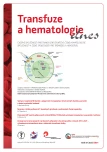A comparison of GIT toxicity of the BEAM and TEAM conditioning before autologous transplantation in patients with lymphomas
Authors:
B. Břízová; A. Jungová; D. Lysák; J. Šrámek; V. Bergerová; P. Jindra
Authors‘ workplace:
Hematologicko-onkologické oddělení, FN Plzeň
Published in:
Transfuze Hematol. dnes,29, 2023, No. 4, p. 259-262.
Category:
Original Papers
doi:
https://doi.org/10.48095/cctahd2023prolekare.cz13
Overview
The BEAM regimen, i.e., carmustine (BCNU) in combination with etoposide, cytarabine, and melphalan was used as standard conditioning prior to autologous hematopoietic cell transplantation (ASCT) in relapsed or refractory lymphomas. However, the recent unavailability of BCNU necessitated the use of an alternative regimen, which in our centre became from July 2018 the so-called TEAM regimen containing thiotepa. We decided to retrospectively compare the gastrointestinal (GIT) toxicity of both conditioning regimens. We included 142 consecutive autologous transplant patients (BEAM = 82, TEAM = 60), of whom 31% had diffuse large B-cell lymphoma (DLBCL), 20% Hodgkin‘s lymphoma (HL), 15 % mantle cell lymphoma (MCL), 14% T-cell lymphomas (T-NHL) and the remaining 20% other types of non-Hodgkin lymphomas (NHL). Both cohorts were comparable in terms of patient age, prevalence of diagnoses, and disease status at the time of ASCT. There was no statistically significant difference in the distribution of the grades of GIT toxicity between the two cohorts, even after grouping all grades into two main groups of patients (grade 0+1 vs. grade 2–4). Patients receiving the TEAM regimen were more likely to require parenteral nutrition, namely in 20 cases (33%) versus only 13 cases (16%) in the BEAM regimen (P = 0.04). Non-relapse mortality (NRM) was comparably low for both regimens – 0% during hospitalization and 2% at 3 months for both conditioning regimens (P = 1.0). We also compared overall survival (OS) and progression-free survival (PFS): there was no statistically significant difference between the two cohorts (P = 0.59 for OS, P = 0.1 for PFS).
Keywords:
conditioning – autologous haematopoietic cell transplantation – lymphoma – GIT toxicity – carmustine – thiotepa
Sources
1. Coiffier B, Lepage E, Briere J, et al. CHOP chemotherapy plus rituximab compared with CHOP alone in elderly patients with diffuse large-B-cell lymphoma. N Engl J Med. 2002; 346 (4): 235–242. doi: 10.1056/NEJMoa011795.
2. Elis A, Blickstein D, Klein O, Eliav-Ronen R, Manor Y, Lishner M. Detection of relapse in non-Hodgkin‘s lymphoma: role of routine follow-up studies. Am J Hematol. 2002; 69 (1): 41–44. doi: 10.1002/ajh.10017.
3. Ansell SM. Hodgkin lymphoma: A 2020 update on diagnosis, risk-stratification, and management. Am J Hematol. 2020; 95 (8): 978–989. doi: 10.1002/ajh.25856.
4. Kothari J, Foley M, Peggs KS, et al. A retrospective comparison of toxicity and initial efficacy of two autologous stem cell transplant conditioning regimens for relapsed lymphoma: LEAM and BEAM. Bone Marrow Transplant. 2016; 51 (10): 1397–1399. doi: 10.1038/bmt. 2016.134.
5. Philip T, Guglielmi C, Hagenbeek A, et al. Autologous bone marrow transplantation as compared with salvage chemotherapy in relapses of chemotherapy-sensitive non-Hodgkin‘s lymphoma. N Engl J Med. 1995; 333 (23): 1540–1545. doi: 10.1056/NEJM199512073332305.
6. Caballero MD, Rubio V, Rifon J, et al. BEAM chemotherapy followed by autologous stem cell support in lymphoma patients: analysis of efficacy, toxicity and prognostic factors. Bone Marrow Transplant. 1997; 20 (6): 451–458. doi: 10.1038/sj.bmt.1700913.
7. Chen YB, Lane AA, Logan B, et al. Impact of conditioning regimen on outcomes for patients with lymphoma undergoing high-dose therapy with autologous hematopoietic cell transplantation. Biol Blood Marrow Transplant. 2015; 21 (6): 1046–1053. doi: 10.1016/j.bbmt.2015.02.005.
8. Colita A, Colita A, Bumbea H, et al. LEAM vs. BEAM vs. CLV conditioning regimen for autologous stem cell transplantation in malignant lymphomas. Retrospective comparison of toxicity and efficacy on 222 patients in the first 100 days after transplant, on behalf of the Romanian Society for Bone Marrow Transplantation. Front Oncol. 2019; 9: 892. doi: 10.3389/fonc.2019.00892.
9. Olivieri J, Mosna F, Pelosini M, et al. A comparison of the conditioning regimens BEAM and FEAM for autologous hematopoietic stem cell transplantation in lymphoma: an observational study on 1038 patients from Fondazione Italiana Linfomi. Biol Blood Marrow Transplant. 2018; 24 (9): 1814–1822. doi: 10.1016/j.bbmt. 2018.05.018.
10. Common Terminology Criteria for Adverse Events (CTCAE), Version 5.0, November 2017, National Institutes of Health, National Cancer Institute. Available at: https: //ctep.cancer.gov/protocoldevelopment/electronic_applications/docs/CTCAE_v5_Quick_Reference_8.5x11.pdf (Accessed March 27, 2018).
11. Passweg JR, Baldomero H, Chabannon C, et al. European Society for Blood and Marrow Transplantation (EBMT). Impact of the SARS-CoV-2 pandemic on hematopoietic cell transplantation and cellular therapies in Europe 2020: a report from the EBMT activity survey. Bone Marrow Transplant. 2022; 57 (5): 742-752. doi: 10.1038/s41409-022-01604-x.
12. Passweg JR, Baldomero H, Bader P, et al. Hematopoietic stem cell transplantation in Europe 2014: more than 40 000 transplants annually. Bone Marrow Transplant. 2016; 51 (6): 786–792. doi: 10.1038/bmt.2016.20.
13. Sellner L, Boumendil A, Finel H, et al. EBMT Lymphoma Working Party. Thiotepa-based high-dose therapy for autologous stem cell transplantation in lymphoma: a retrospective study from the EBMT. Bone Marrow Transplant. 2016; 51 (2): 212–218. doi: 10.1038/bmt.2015.273.
14. Frietsch JJ, Miethke J, Linke P, et al. Treosulfan plus fludarabine versus TEAM as conditioning treatment before autologous stem cell transplantation for B-cell Non-Hodgkin lymphoma. Bone Marrow Transplant. 2022; 57 (7): 1164–1170. doi: 10.1038/s41409-022-01701-x.
15. Marchesi F, Capria S, Pedata M, et al. BEAM conditioning regimen ensures better progression-free survival compared with TEAM but not with FEAM in lymphoma patients undergoing autologous stem cell transplant. Leuk Lymphoma. 2020; 61 (9): 2238–2241. doi: 10.1080/10428194.2020.1765238.
Labels
Haematology Internal medicine Clinical oncologyArticle was published in
Transfusion and Haematology Today

2023 Issue 4
Most read in this issue
- What is new in the treatment of peripheral T-cell lymphomas in the Czech Republic
- Role of NK cell receptors in allogeneic stem cell transplantation in patients with acute myeloid leukaemia
- Do we need a system for sharing spare blood products?
